Timeline of Musical Styles & Guitar History
- In The Beginning
- 1400 – 1600 Renaissance Period
- 1600 – 1760 Baroque Period
- 1730 – 1820 Classical Period
- 1815 – 1910 Romantic Period
- 1911 – present
The use of specific musical instruments follows public tastes in musical styles. To understand the stringed instruments of any age, it helps to know something of the historical context that led to their development: both the musical precedents and the historical events that had an impact at the time. Music, especially songs with lyrics, is commonly written in response to current events – common experience seeking expression. The following timeline is a work-in-progress of the history of the guitar and its role in supporting musical styles. If you have corrections, clarifications, additional thoughts, insights or information, please contact us.
In the Beginning
- According to Farabi, the oud was invented by the sixth grandson of Adam, Lamech. Legend has it that the grieving Lamech hung the body of his dead son from a tree. As the bones of the skeleton bleached in the sun and dry air, they inspired the shape of the first oud. The music of the oud was deemed suitable for the praise of Allah.
3000 BCE
- The oldest pictorial record of a lute-like stringed instrument dates back to the Uruk period in Southern Mesopotamia-Iraq (current-day Nasria city) on a cylinder seal acquired by Dr. Dominique Collon and currently housed at the British Museum. The image depicts a female crouching with her instruments upon a boat, playing right-handed. These instruments appear throughout Mesopotamian and ancient Egyptian history from the 18th dynasty onwards. They appear in long and short-neck varieties. There are examples at the Metropolitan Museums of New York, Philadelphia, Cleveland, and the British Museum on clay tablets and papyrus paper. The close relatives to these instruments have been a part of the music of each of the ancient civilizations that have existed in the Mediterranean and the Middle East regions, including the Sumerians, Akkadians, Persians, Babylonians, Assyrians, Armenians, Greeks, Egyptians, and Romans.
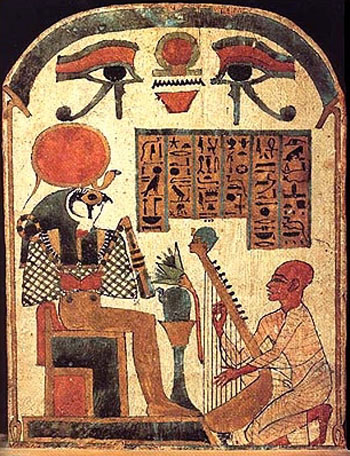
Harpist playing and singing before the Egyptian god Ra Harakhte. XXI Dynasty, 1069-945 BC.
1011 BCE
- The future King Solomon was born. In approximately 985 BCE Solomon penned the lyrics to the 1965 AD number 1 hit “Turn! Turn! Turn!” as covered by the Byrds. The words were recorded in Ecclesiastes 3:1. The music was later provided by Pete Seeger in 1959 AD. This makes King Solomon the earliest known author (with writer’s credit) of a Billboard 100 charted hit.
7 BCE
- In late March and early April, the conjunction of Jupiter and Saturn produced an unusually bright light in the sky. This celestial event is assumed to be the star that led the three wise men to the city of Bethlehem. This also agrees with the appropriate time of year for a census, called for by Augustus Caesar (31 BC – 14 AD), requiring all to return to their place of birth to be counted. Spring is the appropriate time for travel. As this occurred during the local reign of Herod (who died on March 12th or 13th, 4 BCE), it is the likely birth date for Jesus Christ.
325
- Christianity becomes the official religion of the Roman Empire. As Emperor Constantine had converted to Christianity, he felt it was appropriate that the rest of the Empire should follow suit. This change was fertile ground for the creation of many new songs.
500 – 1400 AD (CE) – Medieval Period
- During the Middle Ages, guitars with 3, 4 and 5 strings were already in use. The Guitarra Latina had curved sides and is thought to have come to Spain from elsewhere in Europe. The Guitarra Morisca, as brought to Spain by the Moors, had an oval soundbox and many sound holes on its soundboard.
590 – 604
- The Gregorian Chant was developed, also known as the Plain Chant or Plainsong. It was named in honor of Pope St. Gregory the Great and used formally in all church services. Through the influence of the Church, the new form of music spread quickly toward the West.
695
- There is evidence of the early form of counterpoint — the development of ‘Organum’.
711 AD (CE)
- The oud was most likely introduced to Western Europe by the Moors — Arabs who established the Umayyad Caliphate of Al-Andalus on the Iberian Peninsula. Oud-like instruments such as the Ancient Greek Pandoura and the Roman Pandura likely made their way to the Iberian Peninsula much earlier than the oud, but it was the royal houses of Al-Andalus that cultivated the level of oud playing and raised the popularity of the instrument. The most famous oud player of Al-Andalus was Zyriab. He established the first music conservatory in Spain and added a fifth course to the instrument. The European version of the oud came to be known as the lute (luth in French, laute in German, liuto in Italian, luit in Dutch, and alaud in Spanish). The word “luthier,” meaning stringed instrument maker, is also derived from the French luth. Unlike the oud, the European lute introduced frets (usually tied gut).
- Construction of the oud is similar to the lute. The back of the instrument is made of thin wood staves, edge-glued together. The instrument usually has an odd number of staves — a center stave rather than a center seam. Contrasting trim pieces are often used between staves. Patterns and wood species generally vary between luthiers. The top is generally made of two book-matched pieces of spruce. Transverse spruce braces are glued to the underside of the top. The necks were generally made of a single piece of wood and veneered in a striped pattern similar to that of the back. The peghead meets the neck at a severe angle.
850
- The vocal structure of the Gregorian Chants used in Roman Catholic Church services began to evolve from simple chants to parallel intervals — the development of polyphony and eventually harmony.
1000 – 1100
- The 11th and 12th centuries saw the rise of the Troubadour and Trouvére — a developing tradition of secular song about chivalry and courtly love. One of the better-known Troubadours of the period was Guillaume d’Aquitaine.
1150 – 1250
- Rhythmic music notation appeared during this time and the center of musical activity in Europe was found at the Notre Dame school of polyphony.
- One strain of music during this period was ‘Geisslerlieder,’ the songs of the flagellants. It was simple ‘folk’ music practiced by believers of self-mortification — they would whip themselves to demonstrate humility and worthiness.
1100 – 1300
- In Germany, lyric and songwriting in the Troubadour tradition from France took hold and became known as ‘Minnesang’. The topics were still courtly love and secular pleasures. Those who made names for themselves included Hartmann von Aue, Henric van Veldeke and Wolfram von Eschenbach.
1265
- The first mention of a guitar in historical records.
1349
- Records exist of the Duke of Normandy employing musicians playing instruments known as Guiterre Morische (Moorish Guitar) and Guitarra Latina (Latin Guitar). The Guiterre Morische evolved into the European Lute and the modern Arabic oud. The Guitarra Latina, however, eventually evolved into the guitar.
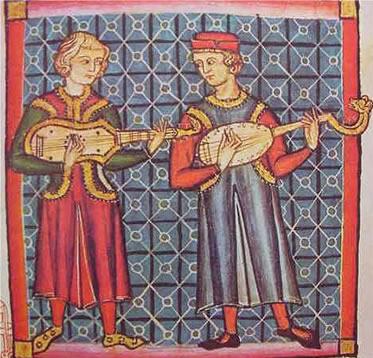
A guitarra latina (left) and guitarra morisca (right), Castile/Spain circa 1320.
1400 – 1600 Renaissance Period
- The gittern (English for Renaissance guitar) resembles a small lute or guitar. It was carved from a single piece of wood with a curved (“sickle-shaped”) peghead. An examplee has survived from around 1450.
- The increasing reliance on the interval of the third as a consonance is one of the most pronounced features of early Renaissance European art music (in the Middle Ages, thirds had been considered dissonances: see interval). Polyphony, in use since the 12th century, became increasingly elaborate with highly independent voices throughout the 14th century. The beginning of the 15th century showed simplification, with the voices often striving for smoothness. This was possible because of a greatly increased vocal range in music — in the Middle Ages, the narrow range made necessary frequent crossing of parts, thus requiring a greater contrast between them. Stringed instruments gained strings to extend their usable range.
- The modal (as opposed to tonal) characteristics of Renaissance music began to break down towards the end of the period with the increased use of root motions of fifths. This later developed into one of the defining characteristics of tonality.
- The Italian humanist movement, rediscovering and reinterpreting the aesthetics of ancient Greece and Rome, influenced the development of musical style during the period.
- The first guitars are thought to have originated during the 15th Century in Spain. These had four ‘courses’ of strings or sets of two strings tuned to the same note to give the guitar resonance. However the Lute was consistently favored by the public over the Guitar until the end of the 15th Century.
1487
- Johannes Tinctoris described two forms of the instrument — one “invented by the Spanish which both they and the Italians call the viola… This viola differs from the lute in that the lute is much larger and tortoise shaped, while the viola is flat and curved inwards on each side.” ‘Viola’ or ‘vihuela’ in Spanish, is not referring to the modern viola, but an early guitar. The other instrument described by Tinctoris is “the instrument invented by the Catalans, which some call the guiterra and others the ghiterne… the guiterra is used most rarely because of the thinness of its sound. When I heard it in Calaonia, it was being used much more often by women to accompany love songs, than by men.” In Italy these were known by other names: the ‘viola da mano’ with six courses of strings and the ‘chitarra’ with 4 courses of strings (or ‘guitarra’ in Spain).
1500s
- Faxardo wrote that the guitarra “won’t bear the fingers but must be touched with a fine quill to make it exert its harmony.” Documents of the day refer to the Vihuela de Mano (played with the fingers) and the vihuela de penile (played with a quill).
- Tobias Stimmer (1539-84) stated, “One can tell by the looks of it that it served as an introduction to the lute for accompanying old songs, for reciting old tales and a good many other things. We should preserve the tradition of our elders.”
1520s
- The Vihuela de Mano (examples can occasionally be found today) was the largest guitar to date. It used gut strings in six courses and was played with a pick, unlike the other early guitar forms, which were bowed.
1535
- Earliest surviving music for the vihuela consisting of Courtly dances and song accompaniments. Seven manuscripts survived; written for the upper classes. The music was transcribed in a form of tablature.
1538
- Various tunings were recorded by Juan Bermudo (1510-65), including ADGBEA and GCFADG. Note the fifths in the former.
1543
- The book De Revolutionibus Orbium Coelestium (On the Revolutions of the Celestial Spheres) by Nicolaus Copernicus (2/19/1473 – 5/24/1543) was published shortly before the author’s death. Copernicus was the first to formulate a comprehensive heliocentric cosmology with the sun – not the earth – at the center of the universe.
1546
- Tres Libros de Musica en Cifras para Vihuela by Alonso Mudarra is published to include music for guitar.
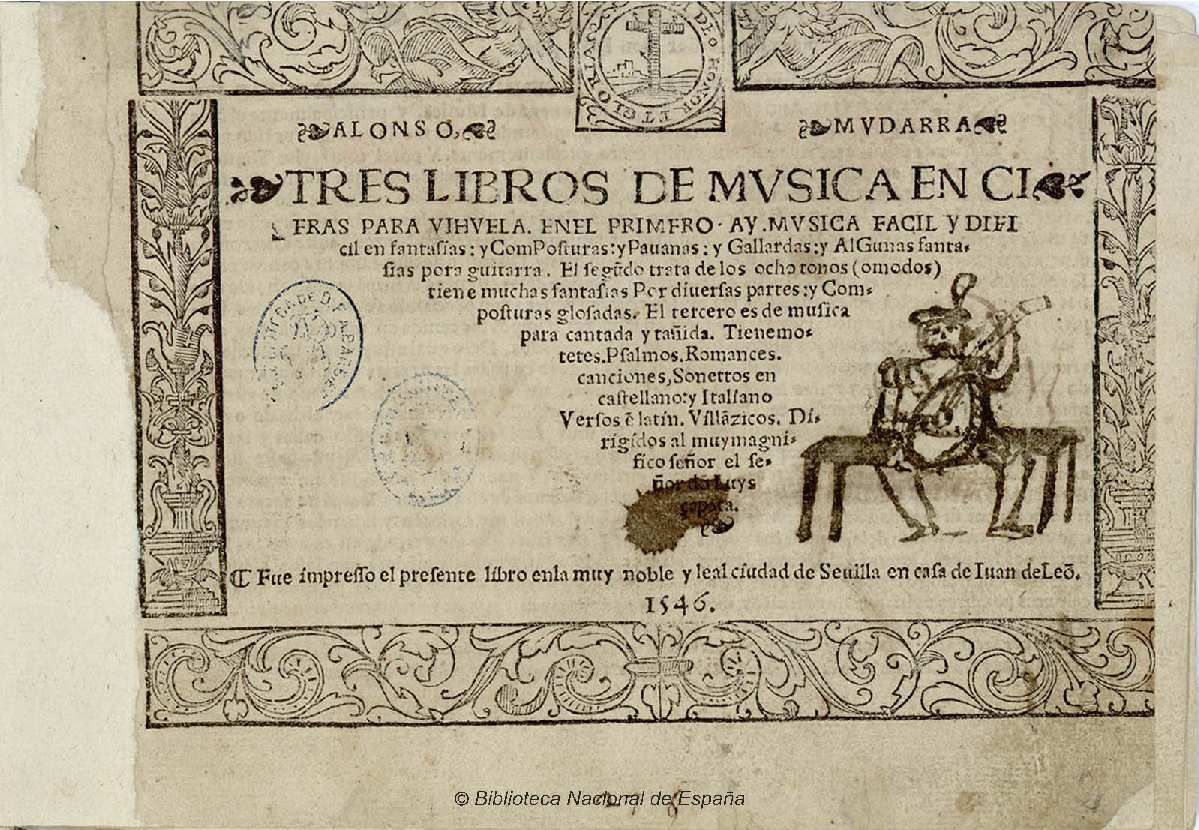
The instructional book Tres Libros de Musica en Cifras Para Vihuela.
1547
- Henry VIII of England had 21 guitars in his collection of musical instruments.
1551-1555
- Nine books of tablature were published by Adrian Le Roy. These include pieces for 5 course guitar. The addition of the 5th course was attributed to Vicente Espinel.
1556
- In the French court a record states, “In my earliest years we used to play the lute more than the guitar, but for 12 or 15 years now everyone has been guitarring.”
1562
- The Counter-Reformation was set in motion by Pope Pius IV as he strove to restore church music to its true essence, by the elimination of all instruments (except the organ), the removal of all melody and harmony, and a return to the simple vocal chant. This, in theory, would help eliminate any trace of secularism that had crept into the church. Giovanni Da Palestrina, while staying within the strict dictates of the Pope’s wishes, composed the piece “Pope Marcellus Mass,” and may have saved polyphony.
1565
- St. Paul’s dictum had prohibited women from performing in public — even in church. The need for soprano and alto parts in harmony was filled by young boys. The problem was that their voices tended to drop with puberty at about the same time that they were well trained and familiar with the ever more difficult singing parts. The solution in Italy was castration. This tended to preserve the high voices. The practice was common by 1574.
1584
- 48-year-old Chu Tsai-yu published a work called A New Account of the Science of the Pitch-Pipes. Though the work was not published outside China at the time, it would have a profound effect on all of Western music. In essence, he solved the problem of equal temperament. There is a misfit between the natural 7 octaves and 12 perfect 5ths equal temperament — they don’t fit. It doesn’t work mathematically and didn’t work tonally. Chu Tsai-yu devised that the 5ths can be tempered not by the relative lengths of the pipes but by the ratios of their sizes. He calculated a formula that yielded a scale of evenly spaced notes where the semitones fit properly into the octave. Ironically, the discovery was irrelevant to Chinese musical theory, which was based upon a 5 tone scale. The Jesuit Priest Matteo Ricci, as part of a group of Jesuit Missionaries in the Southern port of Macao, appears to have passed the information out of China around 1595. See 1620.
1588
- In England, a movement led by Sir Thomas Morley established the English Madrigal School. The complex harmonies were secular in nature and told tales of grief or love.
1590-1604
- Opera is born in the salon of Count Giovanni de Bardi as a group of intellectuals and musicians gathered to find a way to combine music and drama.
1598
- The first Italian opera is produced, Jacopo Peri’s Dafne.
1600
- The second Italian opera is produced, Jacopo Peri’s Euridice.
1600 – 1760 Baroque Period
- The canon promulgated at the Council of Trent (1545 – 63), by which the Roman Catholic Church addressed the representational arts by demanding that paintings and sculptures in church contexts should speak to the illiterate rather than to the well informed. This notion is customarily offered as an inspiration of the Baroque. The move toward a populist conception of the function of ecclesiastical art is seen by many art historians as driving the innovations of Caravaggio and the Carracci brothers, all of whom were working in Rome at that time.
- The appeal of the Baroque style shifted consciously from the witty, intellectual qualities of 16th century Mannerist art to a visceral appeal aimed at the senses. It used direct, simple, obvious, and dramatic iconography. Baroque art drew on certain broad and heroic tendencies in Annibale Carracci (and his circle) and flourished with artists such as Caravaggio, and Federico Barocci. Germinal ideas of the Baroque can also be found in the work of Michelangelo and Correggio.
- Baroque music used contrasting phrase lengths, harmony and counterpoint (replacing polyphony) and orchestral color made a stronger appearance.
- During the Baroque period, a 5th course of two strings was added, and several publications especially for guitarists were produced.
- At the end of the Baroque period, the courses were replaced by single strings, and a final string was added to create the six-stringed guitar of today.
- In Europe, musicians and artists were generally supported by the church, the state and the rich. This patronage system had been practiced in Italy for hundreds of years, Including the late 1400s and early 1500s, when Michelangelo worked as a sculptor and artist for the Medici family in Florence.
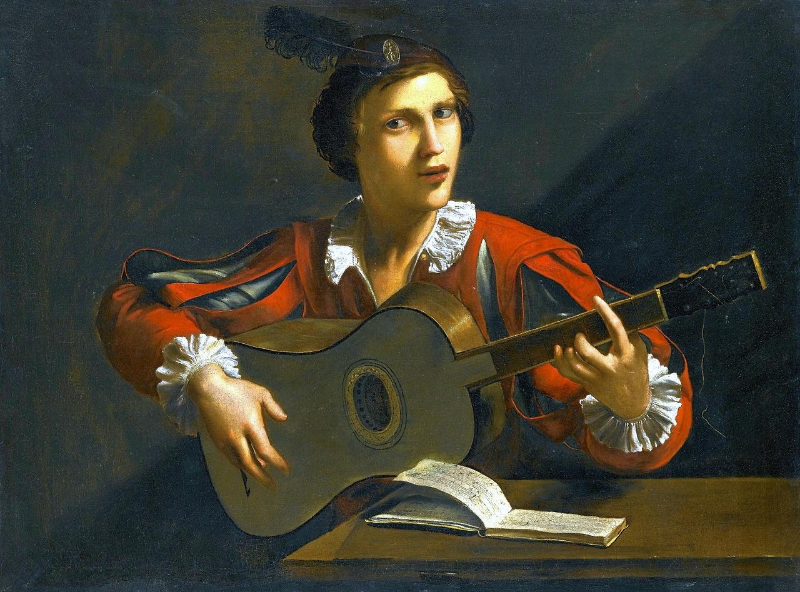
A 5 course baroque guitar and player, by Italian artist Pietro Paolini.
1600-1650
- The guitar’s popularity begins to rival the lute.
- During the Baroque period the 5 course guitar effectively replaced the 4 and 6 course vihuela instruments, and the tuning was largely standardized (with notable exceptions) to ADGBE. Note that this matches the current standard tuning of the top 5 strings.
1611
- Inquisitor Covarrubias complained, “but now the guitar is no more than a cowbell: so easy to play, especially rasgueado (strumming), that there is not a stable lad who is not a musician on the guitar.”
1620
- Belgian mathematician Simon Stevin died. In his notes and papers was the formula for equal temperament by Chu Tsai-yu from 1584. The timing was perfect — equal temperament was the issue of the day with advancements in harmony and composition. It would be many years before the issues were fully resolved, and the refined scale was hotly debated. It was not until the era of Beethoven that the equally tempered scale was fully adopted by Western composers.
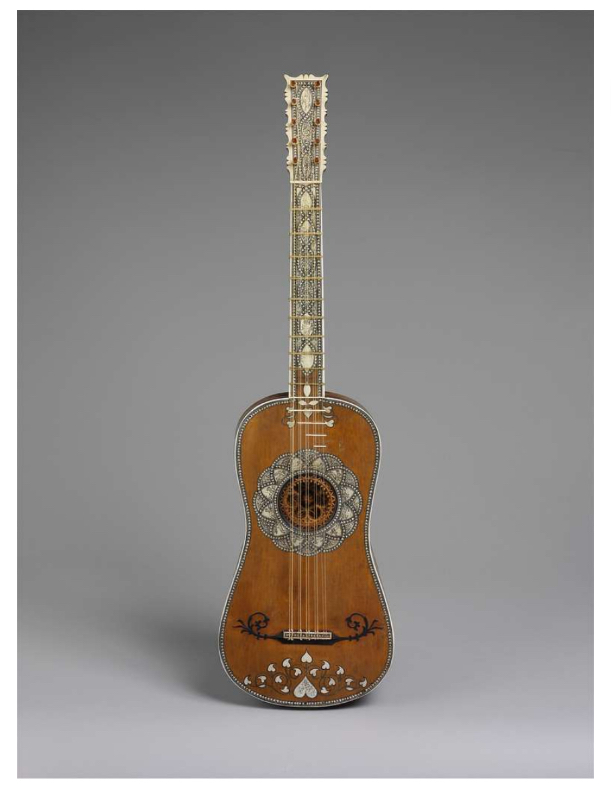
A guitar from 1630.
1671
- Francesco Corbetta (composer and guitar virtuoso) dedicates “La Guitarre Royal” to King Charles II. Charles was a guitar player as well.
1672
- Dutch Master Johannes Vermeer paints Lady With a Guitar.
1674
- The publication of “La Guitarre Royal” by F. Corbetta was dedicated to Louis XIV. It served to increase the popularity of the guitar.
1687
- The book Philosophiæ Naturalis Principia Mathematica by Sir Isaac Newton (12/25/1642 – 3/20/1727) was published. Newton demonstrated that the motions of objects on earth and celestial bodies are governed by the same set of natural laws. He demonstrated consistency between Kepler’s laws of planetary motion and his own theory of gravitation. This removed remaining doubts about heliocentrism (see 1543) and set the stage for advances in the scientific view of the physical universe for the next three centuries.
1680 – 1688
- Antonio Stradivari (1644 – December 18th, 1737) set up shop in Cremona in 1660. He had been an apprentice to Nicolo Amati, and created some of the most treasured violins in history during his golden period —1698 and 1720. As a luthier, he fashioned many different types of instruments, including a very small number of guitars between 1680 and 1688. Surviving examples are maple backed and have ebony fretboards and inlays and a scale length of 74 cm. He is said to have built or collaborated on more than 1,101 instruments total. Approximately 650 instruments survive today.
1690
- Bartolomeo Cristofori (1655-1731) went to work at the court of Prince Ferdinand de’ Medici in Florence as a designer and custodian of keyboard Instruments. He is noted for various innovations in harpsichord construction and especially for the invention of the piano.
1697
- William Turner wrote, “The fine easie ghittar, whose performance is soon gained, at least after the brushing way, hath at this time overtopt the nobler lute…. Nor is it to be denied that after the pinching way, the ghittar makes some good work.”
1711
- Francesco Mannucci noted in his diary in February of 1711 that in 1698, Bartolomeo Cristofori began work on the “arcicembal che fa il piano e il forte” (harpsichord with soft and loud) The inventory of Medici instruments for 1700 show that at least one had been completed by that date. According to Scipione Maffei in 1711, In 1709 Cristofori had built three “gravicembalo col piano e forte” They had a mechanical action that made it possible to simultaneously strike as many notes as one had fingers. The mechanical action had hammers that tapped the heavy string courses and a shift so the hammer would play only one of the two strings for lower volume. The idea was not immediately popular in Italy. Harpsichord players found the touch difficult to master and were not comfortable with the unfamiliar tone.
1725
- Antonio Vivaldi composes “The Four Seasons.”
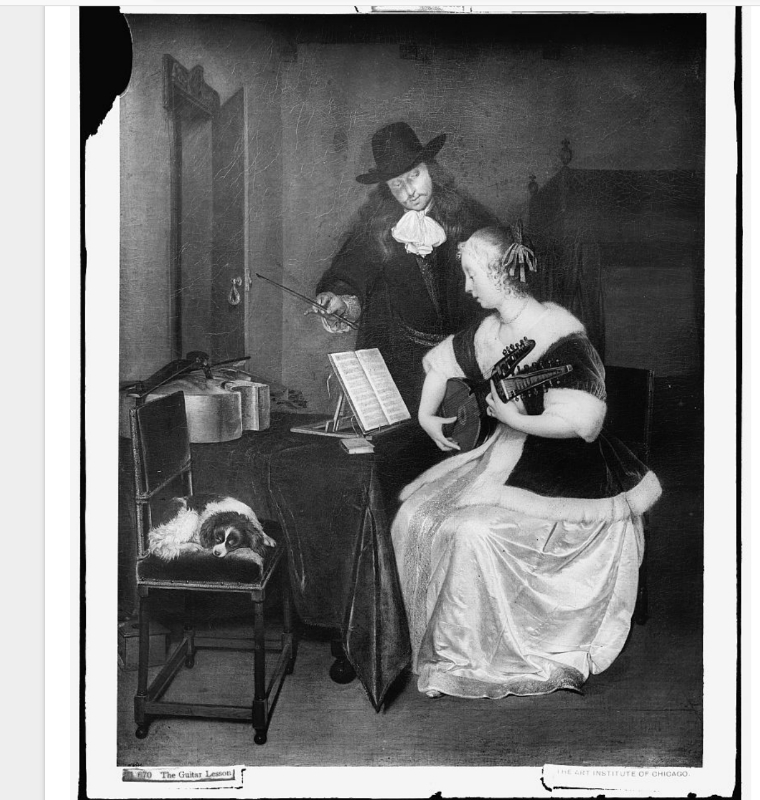
The Guitar Lesson
1730 – 1820 Classical Period
- Europe began to move to a new style in architecture, literature, and the arts, now described as Classicism. While still tightly linked to the court culture and absolutism, with its formality and emphasis on order and hierarchy, the new style was cleaner, and favored a clearer division between parts, brighter contrasts and colors, and simplicity rather than complexity. The development of ideas in “natural philosophy” established itself in the public consciousness (with Newton’s physics taken as a paradigm) — structures should be well-founded in axioms and be both well-articulated and orderly. This taste for structural clarity worked its way into the world of music, moving away from the layered polyphony of the Baroque period, towards a style where a melody over a subordinate harmony — a combination called homophony — was preferred. This meant that the playing of chords, even if they interrupted the melodic smoothness of a single part, became a much more prevalent feature of music. This, in turn, made the tonal structure of works more audible.
- Changes in the economic and in social structure also moved the new style forward. As the 18th century progressed, the nobility became the primary patrons of instrumental music, and there was a rise in the public taste for comic opera. This led to changes in the way music was performed, the most crucial of which was the move to standard instrumental groups and the reduction in the importance of the continuo — the harmonic fill beneath the music, often played by several instruments. One way to trace this decline of the continuo and its figured chords is to examine the decline of the term obbligato (meaning a mandatory instrumental part in a work of chamber music). In the Baroque world, additional instruments could be optionally added to the continuo; in the Classical world, all parts were noted specifically (though not always notated), so the word ‘obbligato’ became redundant. By 1800, the term was virtually extinct.
- The best-known composers of this period are Joseph Haydn, Wolfgang Amadeus Mozart and Ludwig van Beethoven. Beethoven is also sometimes regarded either as a Romantic composer or a composer who was part of the transition to the Romantic; Franz Schubert is also something of a transitional figure. The period is sometimes referred to as the era of Viennese Classicism (German: Wiener Klassik), since Wolfgang Amadeus Mozart, Joseph Haydn, Ludwig van Beethoven, and Franz Schubert all worked at some time in Vienna, comprising the First Viennese School.
- During the Classical Period there were many publications, composers and performers of the classical guitar including Gaspar Sanz (1640-1710), Fernando Sor (1778-1839), Mauro Giuliani (1781-1829)
1735+
- Gottfried Silberman read a German-language account of Scipione Maffei’s article on Bartolomeo Cristofori’s “gravicembalo col piano e forte” and started experimenting on the new design. Bach tried one of his pianos but did not like the heavy touch and weak treble. Eventually Silberman obtained a more accurate description of Cristofori’s action. It is reported that Bach was well pleased with Silberman’s latest piano design, which had an action identical to the 1720s Cristofori pianos that survive to this day.
- Serious works for the guitar were few and far between during the rise of the new piano and the Classical Period. The guitar assumed the role of an instrument of polite society for the amorous and frivolous. There were, of course, notable exceptions like the works of Domenico Scarlatti (1685-1757) of whom it was said that “surely no composer ever fell more deeply under its spell” (referring to the guitar).
1742
- Handel’s “Messiah” premiers in Dublin, Ireland. The piece is enthusiastically received.
1750
- J.S. Bach dies. Many view this as the end of the Baroque Period.
1750 – 1850
- The six-string guitar evolved — multiple courses had been almost entirely replaced by single strings, and many prominent composers such as Fernando Sor, Mauro Guiliani, Matteo Carcassi, and Dioniso Aguado performed and instructed students in the art of guitar playing. The popularity of guitar grows throughout Europe.
1770 – 1827
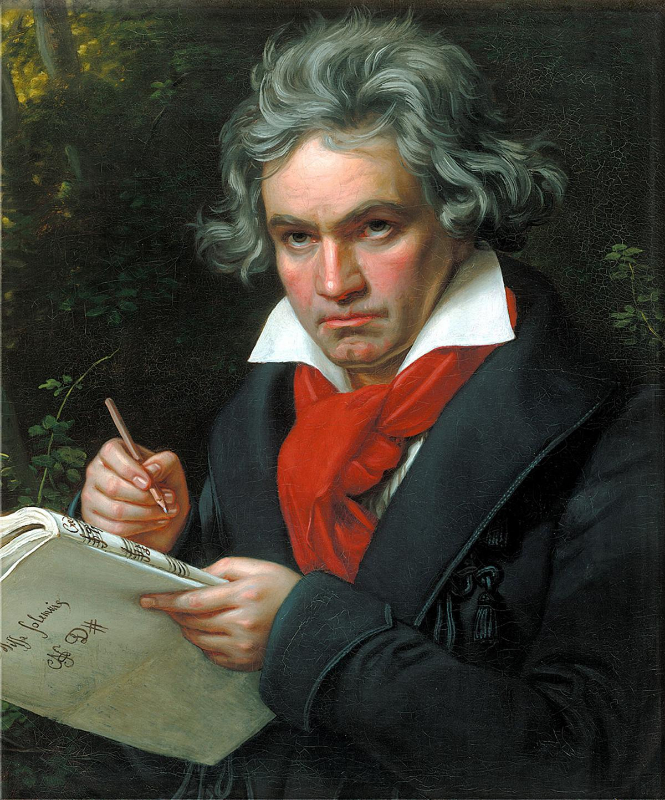
Ludwig van Beethoven
- Ludwig van Beethoven (12/17/1770 – 3/26/1827) German composer and pianist. He is viewed by many as the most influential figure in the transitional period between the Classical and Romantic eras in Western music. He studied under Joseph Haydn and gained a reputation as a virtuoso pianist as a young man. His hearing began to deteriorate in the late 1790s, and yet he continued to perform, conduct and compose even after becoming completely deaf.
1775
- The British soldiers stationed in America penned a simple tune and lyrics to mock the American regulars. The ditty was titled “Yankee Doodle Dandy.” The Americans liked the catchy little tune and quickly adopted it as their own.
1779
- The earliest known existing 6-string guitar was built in 1779 by Gaetano Vinaccia (1759 – 1831) in Naples, Italy. The Vinaccia family of luthiers is known for developing the mandolin. This guitar has been examined and does not show telltale signs of modifications from a double-course guitar. The authenticity of guitars allegedly produced before the 1790s is often in question.
1780s
- Across Europe, the trend in guitar design was toward instruments with sixindividual strings. The movement was led by the French and the Italians. Spain, for the most part, continued with 6-course instruments. The tuning that evolved as most popular was EADGBE.
1786
- Mozart’s The Marriage of Figaro opens in Vienna.
1789-1799
- The French Revolution is a period of political and social upheaval for France that ultimately affected every European power. The absolute French monarchy with feudal privileges for the aristocracy and Catholic Clergy was violently overthrown and replaced with a government formed under the Enlightenment and based on principals of citizenship and inalienable rights. The transition was not smooth.
- Following the French Revolution, property confiscated from the aristocracy by the Committee for the Public Safety included dozens of guitars.
1792
- Moretti’s 6-string method was published.
1799
- The Principal for Playing Guitar with Six Strings by Federico Moretti was published.
1803
- Beethoven composed “Eroica,” his third symphony. To many, this marks the beginning of the Romantic Period.
1806
- Attending a concert by guitar virtuoso Mauro Giuliani in Vienna, Ludwig Van Beethoven declared, “the guitar is an orchestra in itself!”
1807
- Beethoven composed “Symphony No. 5,” considered by some as the most popular classical work ever written.
1809
-
- Charles Robert Darwin (February 12th, 1809 – April 19th, 1882), an English naturalist, who developed the theory of natural selection, evolution, was born. President Abraham Lincoln was born on the same day.
1814
- During the night of September 13-14, at the battle of Baltimore (War of 1812), 35-year-old lawyer and amateur poet Francis Scott Key watched the British bombardment of American forces at Fort McHenry. In the morning, as the smoke cleared, he saw the American flag still waving. He was inspired to poetry, and composed “The Defense of Fort McHenry” that was published in the Patriot on September 20th, 1814. The poem was later set to the tune of a popular British song written by John Stafford Smith for the Anacreontic Society (a men’s social club in London). “The Anacreontic Song” (or “To Anacreon in Heaven”), with various lyrics, was already popular in the United States. The new arrangement was especially appropriate to the patriotic fervor of the time and became widely popular. It later became known as “The Star-Spangled Banner” and was adopted as the American National Anthem by an executive order of Woodrow Wilson in 1916 and later by Congressional resolution in 1931.
1815 – 1910 Romantic Period
- The era of Romantic music ran roughly from the end of the Napoleonic Wars to around the end of the 19th century.
- “The Romantic Period” is sometimes described as 1770-1830. This was a period of political and intellectual upheaval. Science and art flourished. Germany entered “with energy and brio” onto a stage that had previously been dominated by England, France, Italy and Spain.
- Romantic Music refers to the theory, compositional practice, and canon in European music history, from about 1820 to 1900. ‘Romanticism’ does not necessarily imply romantic love, though the theme was prevalent in many works composed during the period. It is more appropriate to describe romanticism as the expansion of formal structures within a composition, making the pieces more emotionally expressive. Because of the particular use of these elements of form, key, instrumentation, etc. within a typical composition, it became easier to identify an artist based on the work. For example, Beethoven favored a smooth transition from the 3rd to 4th movement in his symphonies, and therefore his pieces are easier to identify.
1825
- François René Lacote was laying the groundwork for the modern guitar: building guitars in France with fixed metal frets, fixed bridge with ivory saddles, bridge pins and tuners arranged in slotted headstocks like classical guitars today. Though small, the guitars were braced similarly to today’s classical instruments and were remarkably loud. This made public performance possible.
- Johann Anton Stauffer (Vienna, Austria, 1805 & after 1851) working with guitar virtuoso Rinaldo Luigi Legnani (1790-1877) who was also an amateur violin and guitar maker, developed a guitar design that performed particularly well both in volume and tone.
1827+/-
- While records of the period are sketchy, it would appear that the young Christian Frederick Martin entered an apprenticeship with Johann Anton Stauffer and proved to be a gifted craftsman, as he was named foreman of Stauffer’s shop shortly after his arrival.
1831
- “My Country ‘Tis of Thee” (also known as “America”) was first sung at Park Street Church in Boston. Words by Samuel Francis Smith, set to the tune of “God Save the King.”
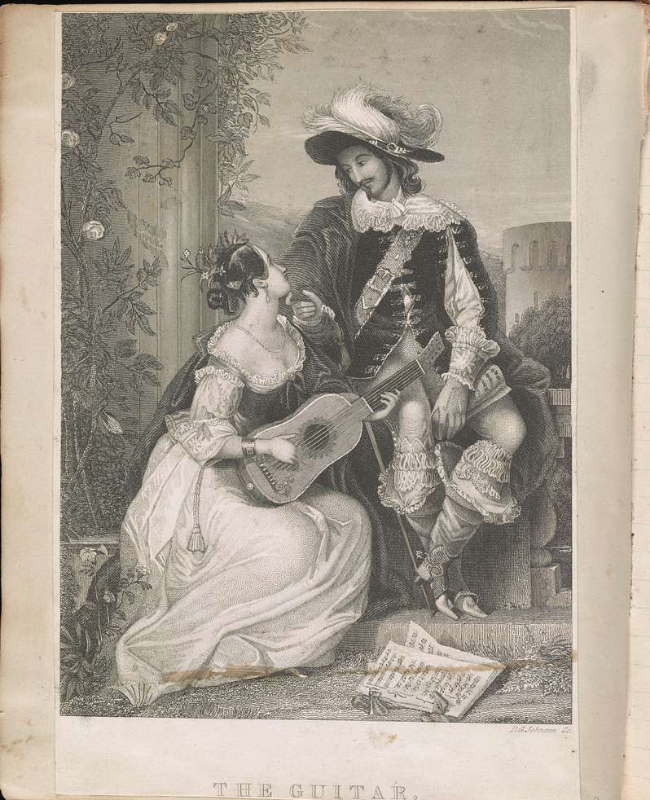
This print from 1830 shows a woman playing guitar as a man flirts with her.
1833
- 37-year-old Christian Frederick Martin left Germany and the oppressive rules of the Instrument Guilds on September 9th, 1833 for New York City. Upon arrival, he quickly set up shop at 196 Hudson Street on the Lower West Side. His modest storefront housed limited guitar production in the back room and retail space selling everything from cornets to sheet music.
- Samuel Colt perfected the 1st handgun with a revolving cylinder: the legendary 6-shooter.
- April 24th, a patent for the 1st soda fountain machine.
- December 3rd: Oberlin College (Ohio) was founded – the 1st American co-educational college and later, the 1st American college to advocate the abolition of slavery and accept black men and women on equal terms with whites.
1835
- The only time in American history when the nation was free of debt.
- The Liberty Bell cracked as it tolled for the death of Chief Justice John Marshall.
- “Amazing Grace” was published to the tune of “New Britain” in William Walker’s The Southern Harmony. This is the version most often sung today. The original lyrics grew from a collaboration between minister John Newton and poet William Cowper, also a born-again Christian. The poem “Amazing Grace” was most likely written in Kineton, Warwickshire around Christmas 1772. The lyrics were based on Newton’s reflections on an Old Testament passage he was preparing for a sermon, adding his perspective about his personal conversion while Captain on his slave ship, the Greyhound, in 1748.
1836
- The Washington Monument was begun by architect Robert Mills.
- 3,000 Mexican troupes stormed the Alamo on March 6th. It was defended by 182 Texans including James Bowie, Col. William B. Travis and Tennessean Davy Crocket.
1837+/-
- Paralleling Francisco Tarrega’s achievements in performance technique was the work of luthier Antonio Torres Jurado (1817-1892). He placed emphasis on the action of the soundboard in producing volume and tone. To improve the instrument he enlarged the body and refined a pattern of fan bracing (still used today). His preferred scale length was 650cm. Many of his improvements are considered the standards of the classical guitar today. His innovations resulted in the formation of the Spanish School of Guitar Making whose membership included the most important luthiers of the late 19th century, including the Ramirez family.
1838
- In Boston Massachusetts, the first American music education was introduced into public schools, by music educator: Lowell Mason. He was best known for his many hymns and anthems, including “Jerusalem, My Glorious Home.”
1839
- C. F. Martin, Sr. moves his family and business to Nazareth, Pennsylvania.
1842

C.F. Martin
- C .F. Martin, Sr. creates the X-bracing pattern for guitar tops to give strength to the guitar top to handle the pressure of taut strings and heavy playing.
- The New York Philharmonic was founded, now the oldest orchestra in the U.S. Originally known as The Philharmonic Society of New York (some feel that actual date of establishment is 1839).
1844
- First private bathtub appeared in a New York hotel. One year later, bathtubs were still prohibited in Boston except when prescribed by a physician.
1845
- First American grand opera, Leonora, by William Henry Fry.
1848
- Harvard president Edward Everett responded to protests over admission of a black man: “If this boy passes the examination, he will be admitted; and if the white students choose to withdraw, all the income of the college will be devoted to his education.”
- Shaker dance song “Simple Gifts” (also known by its first line “‘Tis the gift to be simple”) was composed by Elder Joseph Brackett in Alfred, Maine. Later popularized in arrangements by Aaron Copland (1900-1990).
1850
- Manuel Torres begins refining the construction of the acoustic guitar.
1851
- The New York Times began publication on Sept. 18th.
- Stephen Foster’s biggest hit, “Old Folks at Home,” was published.
1854
- C. F. Martin introduces the 0 model.
1855
- Henry Bessemer patented the Bessemer process which was the first inexpensive industrial process for the mass-production of steel from molten pig iron. This made tall buildings and skyscrapers possible. This also made truss rods possible.
- “Song of the Old Folks” (tune: “Auld Lang Syne”) words adapted by Albert Laighton, written for an Old Folks concert in Reading, Massachusetts and published in Father Kemp’s Old Folks Concert Tunes.
1859
- Charles Darwin published On the Origin of Species by Means of Natural Selection, or the Preservation of Favored Races in the Struggle for Life. It was a seminal work in scientific literature and arguably the pivotal work in evolutionary biology. The sixth edition of 1872 shortened the title to The Origin of Species. It introduced the theory that populations evolve over the course of generations through a process of natural selection. Darwin’s book was the culmination of evidence accumulated on the voyage of the Beagle in the 1830s and expanded through continuing investigations and experiments after his return.
- The biggest Southern hit song, “Dixie,” was written by Daniel Decatur Emmett, a Northerner from Ohio.
1860
- On November 6th, Abraham Lincoln (February 12th, 1809 – April 15th, 1865) was elected as the 16th President of the United States.
1861
- The American Civil War began on April 12th, 1861, when Confederate forces attacked a U.S. military installation at Fort Sumter in South Carolina.
1862
- “Battle Hymn of the Republic” published with words by Julia Ward Howe and set to the tune: “Glory, Hallelujah.” One year earlier, the same tune had been used for “John Brown’s Body” a song written in jest about Sgt. John Brown at Fort Warren in Boston. Both tunes were based on the Methodist hymn “Say, Brothers Will You Meet Us?” by William Steffe.
1863
- December 9th: Treasury Secretary Salmon P. Chase submitted the motto “In God We Trust” to the Treasury Department for use on American currency (see 1864).
1864
- Stephen Collins Foster (July 4th, 1826 – January 13th, 1864) died. Known as the “Father of American music, he was the preeminent songwriter in the United States of the 19th century. His songs, such as Oh! Susanna, Camptown Races, My Old Kentucky Home, Old Black Joe, Beautiful Dreamer and Old Folks at Home (Swanee River) remain popular over 150 years after their composition.
- A Congressional Act approving the motto “In God We Trust” for placement on the 1 cent and newly created 2 cent piece passed April 22nd. This was followed in 1866 by the 5 cent nickel (1866–1883), quarter dollar, half dollar, silver dollar and gold dollars. An 1865 law allowed the motto to be used on all coins. In 1873, the use of the motto was permitted, but not required. While several laws came into play, the act of May 18th, 1908 is most often cited as requiring the motto (even though the cent and nickel were excluded from that law, and the nickel did not have the motto added until 1938). Since 1938, all coins have borne the motto.
1865
- After 620,00 soldiers had died, Confederate resistance collapsed after Lee surrendered to Grant at Appomattox Court House on April 9th. The Civil War had officially ended.
- On Good Friday, April 14th, President Abraham Lincoln was shot while attending a performance of “Our American Cousin” at Ford’s Theatre with his wife and two guests. Lincoln’s assassin, actor and Confederate sympathizer John Wilkes Booth, had also ordered a fellow conspirator, Lewis Powell, to kill William H. Seward (then Secretary of State) and George Atzerodt to kill Vice President Andrew Johnson. Booth hoped to create chaos and overthrow the Federal government. Although Booth succeeded in killing Lincoln, the larger plot failed. Seward was attacked, but recovered from his wounds, and Johnson’s would-be assassin fled Washington, D.C. upon losing his nerve.
1868
- “King of Ragtime” Scott Joplin is born on November 24th, in Texarkana, Texas.
1871
- At 8:30 Sunday evening, October 8th in Chicago, Illinois, a fire started in the barn of Patrick and Catherine O’Leary at 137 De Koven Street and spread out of control to turn the largest city west of Pittsburgh to ashes. During and following the Great Chicago Fire 300 lives were lost, 17,500 buildings destroyed, 100,000 left homeless and an estimated cost of damages at $400,000,000 in 1871 currency. As the retail gateway to the west and mail-order capitol of the world, musical instrument manufacturers and distributors were seriously affected. Many never recovered. Those that survived grew stronger.
- Francisco Tarrega (1852-1909) transcribed many works by Handel, Mozart, Schubert and Bach while teaching at the Conservatory of Barcelona. He was a musical prodigy, guitar virtuoso and composer of numerous timeless pieces for guitar. His groundbreaking playing and performance techniques propelled the popularity of the classical guitar forward and inspired equal leaps in instrument design.
1873
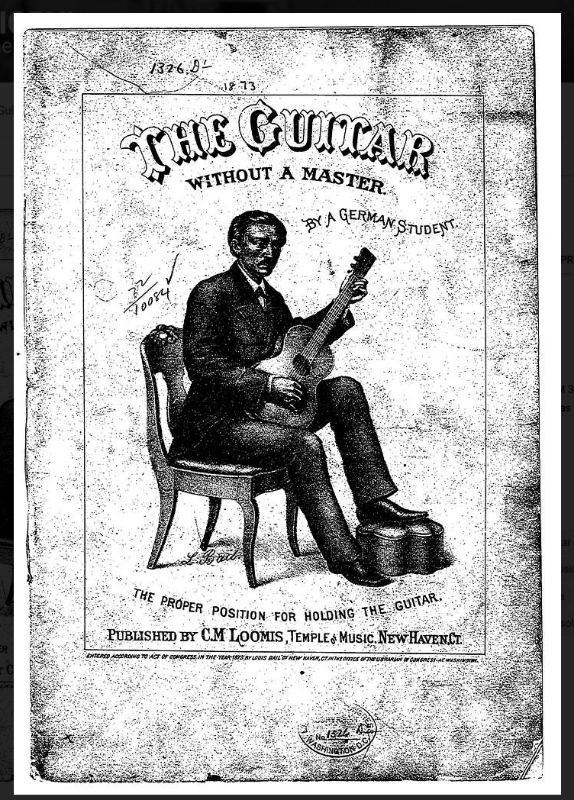
A guitar player’s instructional book from 1873.
1872-1909
- C. F. Martin, Sr. passes away and C. F. Jr. takes command. Sales records of the 00 guitar begin to appear on the books.
1876
- Alexander Graham Bell invented the telephone, adding to the growth potential of the firm Western Electric.
- Three different versions of pianos that played themselves were demonstrated at the Philadelphia Exposition. They would eventually become player pianos.
1877
- Thomas Edison invents the phonograph. It had two diaphragm-and-needle units; one for recording, and one for playback. He could speak into a reverse horn and the sound vibrations were then impressed into delicate tin foil wrapped on a metal cylinder by a recording needle in vertical grooves. His first recorded words were “Mary had a little lamb.” He filed for a patent on December 24th, 1877. The hand cranked phonograph is demonstrated by Edison on November 29th, 1877. The phonograph will eventually allow the spread of popular music.
1879
- Thomas Alva Edison invented the incandescent lamp and Western Electric began to gain stature as a large company.
1880
- The Office of Indian Affairs outlaws a wide range of Native American customs and rituals, beginning with the Sun Dance in 1880.
- The Metropolitan Opera Association was founded to create an alternative to the New York Academy of Music. The Academy represented the highest social circle in New York society and the board of directors resisted admitting members of new wealthy families into their inner circle. The initial group of subscribers included the Morgan, Roosevelt, Astor and Vanderbilt families. Their creation, The Metropolitan Opera, has outlasted the Academy. The 1883-84 season opened with a performance of Charles Gounod’s Faust on October 22nd starring the brilliant Swedish soprano Christina Nilsson performing in Italian.
1881
- Henry Lee Higginson forms the Boston Symphony Orchestra. Higginson would run the Orchestra for almost 40 years.
1882
- Amid a wave of anti-Chinese sentiment, the Chinese Exclusion Act limits the immigration of Chinese people to the United States, leading to a reduction in Chinese musical practices.
- Yiddish theater begins its period of greatest popularity and influence.
1883
- Friedrich Gretsch set up a shop in Brooklyn, New York to build banjos, drums and tambourines, the first drum manufacturer in the United States.
- The Metropolitan Opera opens in New York City.
1885
- A Hawaiian schoolboy by the name Joseph Kekuku is credited with inventing the Hawaiian guitar. The strings are melodically picked and stopped by a metal bar, with the guitar held across the lap.
1886
- John Phillips Sousa’s “The Gladiator” sells more than a million copies, marking a turning point in his career.
- The Berne Convention, the international agreement on copyrights, is signed. The United States does not sign the agreement until 1989.
1890
- Orville H. Gibson (1856-1918) at 34 years old, settled in Kalamazoo, Michigan and took up the hobby of making musical instruments.
1891
- Carnegie Hall Opened in New York City on May 5th. Horse drawn carriages lined the streets for a quarter mile and inside the Music Hall was a capacity crowd. After a dedication speech from Bishop Henry Codman Potter, Walter Damrosch led the Symphony Society in a performance of Beethoven’s Leonore Overture No. 3, followed by Pyotr Ilyich Tchaikovsky conducting his Marche Solennelle.
1892
- The Ryman Auditorium was completed by riverboat shipping magnate Captain Thomas Ryman in Nashville, Tennessee as a home base for traveling evangelist Reverend Samuel Jones.
- At the end of the 19th Century the classical guitar had lost popularity but was re-introduced to the world by Francisco Tarrega, who began the tradition adopted by almost all classical guitarists of today by using the finger-nails to pick the strings.
- September 8th: Francis Bellamy (1855–1931) published the Pledge of Allegiance in the popular children’s magazine: The Youth’s Companion as part of the National Public-School Celebration of 400th anniversary of Columbus Day. The event was conceived and promoted by James B. Upham as a campaign to instill American nationalism by selling flags to public schools and magazines to students. Bellamy was a Baptist minister and a Christian socialist. The original Pledge read as follows: “I pledge allegiance to my Flag and the Republic for which it stands, one nation indivisible, with liberty and justice for all”. (see 1940, 1943, 1948, 1951 & 1954)
- The Harmony (musical instruments) Company was founded in Chicago.
1893
- First use of the word Ragtime appears in the song title “Ma Ragtime Baby” by Fred Stone in 1893.
- Andrés Segovia (1893-1987) is born in the small Spanish Andalusian village of Linares.
- “Happy Birthday” is composed by two teachers in Louisville, Kentucky.
1895
- Thomas Edison invents the motor-driven gramophone. Phonographs are improving but are still a long way away from being commercial.
1896
- In the Supreme Court, Plessey vs. Ferguson establishes the “Separate but Equal” concept that will allow segregation and “Jim Crow” to flourish.
- On May 11th Orville Gibson filed for his first and only patent. The document (U.S. Patent No. 598,245) was issued on February 1st, 1898 and contained his ideas for the construction of a mandolin with a carved top and back, and with sides that were cut from a solid piece of wood rather than being bent from thin strips.
- The creation of the first large Sears and Roebuck Co. catalog. This made possible nationwide distribution of all sorts of products including musical instruments by postal service.
1897
- Buddy Bolden organizes the first band to play the instrumental Blues (the forerunner of Jazz). The band’s repertoire consists of Polkas, Quadrilles, Ragtime and Blues.
- Storyville (the famed red light district of New Orleans) opens. It was named after New Orleans alderman Sidney Story.
- The Ragtime craze is at full tilt.
- The first effective player piano was released to the public and heavily marketed. This would bring piano roll versions of many forms of music into American households over the next 20 years.
1898
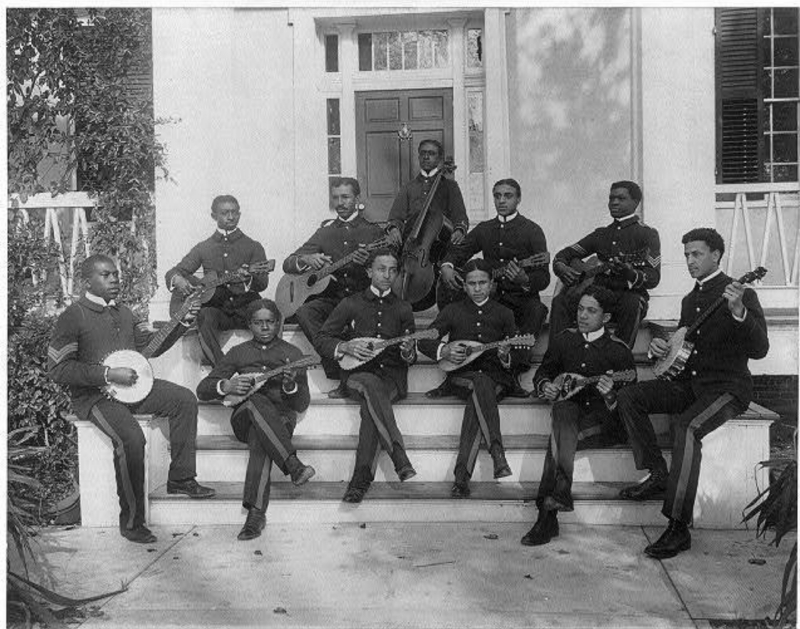
11 students in uniform playing guitars, banjos, mandolins, and cello, at the Hampton Institute in Hampton, VA, circa 1898.
- Orville Gibson, an amateur instrument builder in Kalamazoo Michigan, patented his idea for a one-piece mandolin design with a carved top like a violin.
1899
- Scott Joplin shows some rags to a publisher. The Publisher buys some original rags but turns down “Maple Leaf Rag.” Shortly after, John Stark (farmer, ice cream salesman, piano peddler) hears the “Maple Leaf Rag,” likes it and publishes it for Joplin. It’s a hit and the craze is on. “Maple Leaf Rag” sells over 1,000,000 copies in a year. Stark and Joplin remain friends for years.
1900
- Sigmund Freud publishes The Interpretation of Dreams (Die Traumdeutung, 1899-1900)
- Blues become a standard feature of honky tonks and dance halls. Horn players imitate the human voice with mutes and growls.
- New Orleans players are playing a mix of Blues, Ragtime, brass band music, marches, Pop songs and dances. The Jazz stew is brewing. Some musicians are beginning to improvise Pop songs.
- The end of the Spanish-American war has brought a surplus of used military band instruments into the port of New Orleans.
- Migrations from the south into Chicago, Detroit, Pittsburgh, etc. are beginning.
- Luthier Robert Maurer decided to retire. August Larson gathered investors Edward P. Longworthy and Joshua H. Lewis and bought the firm from Maurer. It was the beginning of the Larson Brothers instruments.
- Andrew Carnegie sold his industrial holdings to J. P. Morgan for $400 million. He managed to give away $308 million of it by his death in 1919.
- A hurricane and tidal wave hit Galveston. Texas on September 8th. The highest point of land on the island was 5 feet above sea level. There was no advance warning and the only access to the mainland was by boat. By the time the residents and visitors knew the danger, there was no means of escape. 6,000 lives were lost. There were so many bodies, they were taken out to sea and dumped. The bodies later washed back up onto the Galveston shores and were burned. This event became the topic of many songs over the next century.
- Len Spencer released his biggest hit “Arkansaw Traveler.” Other Spencer hits included “Ta-Ra-Ra-Boom De Ay.” Len Spencer is believed by some to be the first nationally know recording star.
- In New York City, in an August heat-wave, tensions between white Irish and black Southern immigrants flared into riots at the funeral of a white Irish plain-cloths police officer who had been cut by a black man protecting his girl-friend from harassment. Among those beaten in the riots were Vaudevillian actor, comic, dancer and musician George Walker (1893-1911) as he walked with a friend named Shine. The song: “That’s Why They Call Me Shine” was written in 1910 by Cecil Mack, Ford Dabney (w) & Lew Brown (m) in remembrance of Shine and the riots. The introduction to the song is needed to get the original intent of the song.
1902
- Jelly Roll Morton is 17 years old. He is beginning to be noticed in New Orleans as a brothel piano player. He’s playing Ragtime and a little Blues. He is one of the first to play this mix (forerunner of Jazz). Jelly Roll will later claim that he invented Jazz in 1902 by combining Ragtime, Quadrilles and Blues.
- The phonograph has been drastically improved. Victor and Columbia emerge as leaders in the phonograph field (at that time phonograph companies made records). The public started to buy phonographs and records (cylinders) for home use.
- On the afternoon of October 11th, 1902, Sylvo Reams, Lewis A. Williams, LeRoy Hornbeck, John W. Adams, Samuel K. VanHorn, and Orville H. Gibson met at the County Clerk’s office to form a “Partnership Limited Association” (fundamentally, a business structure in which various investing members had limited liabilities) for the “Gibson Mandolin-Guitar Manufacturing Co., Limited.” Adams, VanHorn, and Hornbeck were lawyers practicing in Kalamazoo. Reams and Williams were both in the retail music business, and all saw the opportunity to capitalize on Orville’s creative talents. Strangely, Orville Gibson’s name was not listed as a member of the Partnership.
- W.C. Handy has started a saxophone quartet. The saxophone was a novelty in 1902.
- Frank Henry Martin introduces the size 000 guitar. This size body is made to compete with mandolins and banjos. The company designs its first Style 45 guitar.
1903
- December 17th, Orville Wright piloted the first machine powered airplane 20 feet above a the beach at Kitty Hawk, North Carolina. The flight lasted 12 seconds and covered 120 feet. Three more flights were made that day with Orville’s brother Wilbur piloting the record flight lasting 59 seconds over a distance of 852 feet.
- W.C. Handy hears the rural blues played on a slide guitar with a knife blade as a slide by an itinerant blues guitarist in a railroad station in Tutwiler, Mississippi. It sparks a career for him.
- Sidney Bechet borrows his brother’s clarinet. The rest is history.
1905
- Albert Einstein’s first theory of relativity, published in 1905, broke away from the Newtonian reliance on space and time as immutable frames of reference.
- 12-string guitarist and rural blues man Huddie “Leadbelly” Ledbetter meets blues man Blind Lemon Jefferson in a Dallas saloon. A partnership is formed.
- New Orleans blues trumpet pioneer Buddy Bolden runs amok and is committed to the state hospital at Angola on June 5. Buddy will spend the rest of his life there and will never be recorded.
- Trumpeter Freddie Keppard and his Creoles were playing more powerful Jazz in New Orleans than the Original Dixieland Jazz Band will play in 1917. Keppard was not recorded until many years later because he was afraid of having his style stolen.
- Columbia produces the first two-sided disc.
- Blues publishing pioneer W.C. Handy brings saxophones into his dance band.
1906
- At 5:13 am on Tuesday, April 18, the ground started to shake in San Francisco the epicenter of an earthquake estimated at 8.5 on the Richter scale. It was felt from Los Angeles to Coos Bay, Oregon, some 730 miles away. It lasted for 48 seconds and in some areas the ground moved 20 feet. All civil services were destroyed or heavily damaged. Since there had been numerous smaller earthquakes over the years (1857, 1865, 1868 & 1890) the city had been rebuilt out of wood. Wood frame, in general, held up better in earthquakes. It also burns. Gas lines were ruptured, ignited, and fires broke out around the ruins of the city. The water lines were also ruptured, so there was little to fight the fires. Communications had been eliminated so the firefighters couldn’t coordinate with each other or even effectively locate the blazes. The population of San Francisco at the time was approximately 450,000.
1907
- The Tango is introduced to America.
- Epiphone opens shop in New York City with the House of Strathopoulo.
- Florenz Ziegfeld expanded the notion of Vaudeville stage shows to new heights by his elaborate productions known as The Ziegfeld Follies.

An advertisement from 1907.
1908
- The first production Ford Model T rolled off the line on September 27th at the Piquette Plant in Detroit, Michigan.
- The most popular song of the year was “Take Me Out to the Ball Game.”
1909
- Andrés Segovia (1893-1987) performed a debut recital in Granada Spain. He performed pieces by Francisco Tárrega, some new transcriptions of piano works by Albéniz and Chopin, and some of his own compositions. It was the beginning of a career of more than 5,000 concerts around the globe and vastly increasing the body of works available for the classical guitar.
- Francisco Tárrega (1852-1909) dies the same year as the debut performance of young Andrés Segovia.
- Chris J. Knutsen developed a new idea, different from his harp guitars: Hawaiian style lap steel guitars that were played with a slide. These were swept-up in Hawaii and presented to the American public in the Panama-Pacific International Exposition in 1915. A new market and style of playing swept the nation.
1910
- The public is losing interest in Ragtime as popular music.
- The first non-American Ragtime sheet music appears in London, England. English musician Vic Filmer begins playing Rags. American black music begins to gain appeal in Europe.
- The Fox Trot dance craze begins.
- Tin Pan Alley sold $2 billion worth of sheet music. Ragtime was so popular that it eventually replaced the ballad as Tin Pan Alleys most marketable product.
- Haley’s Comet flashed across the skies on April 19th.
- In January, radio pioneer Lee De Forest experimented with radio by broadcasting two live performances from the stage of the New York Metropolitan Opera with an erratic signal, that could reportedly be heard as far away as Newark, New Jersey. Music radio was born.
Special thanks to the ‘All About Jazz’ website and the ‘Digital Dream Door’ website for some historical information.
If you want to use any of this information: Please see the Terms of Usage – Usage Policy
© 1995 – 2021 AcousticMusic.Org
